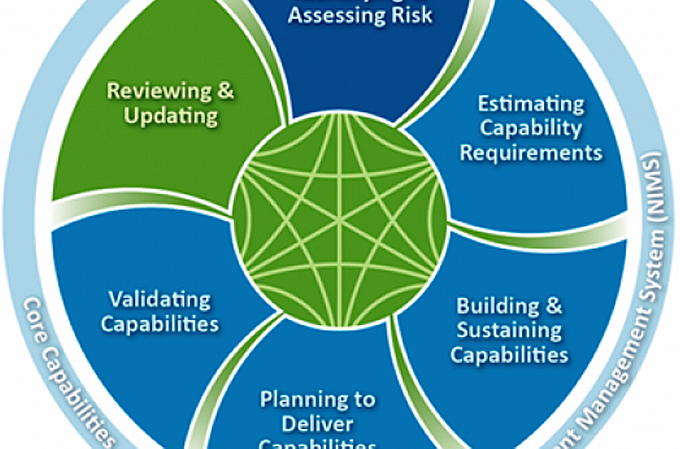
Every day, the Department of Homeland Security (DHS) & the Federal Emergency Management Agency (FEMA) take steps to keep our nation safe and ensure that we thrive after disasters occur.
Whether we face risks related to earthquakes, cyber attacks or chemical spills, our goal is shared: safety and resilience.
As part of the DHS’s ongoing efforts to support state, local, tribal, and territorial partners, Secretary Kirstjen M. Nielsen has announced final allocations of $345 million for six Fiscal Year (FY) 2018 DHS competitive preparedness grant programs.
These allocations together with the more than $1.3 billion in non-competitive grant funding announced by DHS in June, total more than $1.6 billion in FY 2018 granted to assist states, local areas, tribal and territorial governments, nonprofit agencies, and the private sector with their preparedness efforts.

“DHS is committed to building a culture of preparedness with our government, private sector, and nonprofit partners nationwide so we are ready when disaster strikes,” said Secretary Kirstjen Nielsen.
“The DHS grant programs are flexible by design and purposed to help address our evolving risk environment.”
“Response and recovery to catastrophic events strain our communities’ logistics, supply chains, communications, and staffing capacities.”
“When these events occur, time is our most valuable resource.”
“That is why our preparedness grant programs build and sustain critical capabilities today, so we will be ready tomorrow.”
Since 2002, DHS has awarded more than $49 billion to these partners.
Preparedness grants strengthen our nation’s ability to prevent, protect against, mitigate, respond to, and recover from terrorist attacks, major disasters, and other emergencies in support of the National Preparedness Goal and the National Preparedness System.
The National Preparedness System outlines an organized process for everyone in the whole community to move forward with their preparedness activities and achieve the National Preparedness Goal.
(Learn More. Hurricane Matthew caused substantial damage along the southeastern coast of the U.S. and flooding from the storm continues to pose a significant risk in North Carolina. In an interview at the National Academies, Craig Fugate discussed his agency’s “whole-community” approach to emergency management, the need for better data to inform disaster preparedness, and what resilience means to him. Courtesy of The National Academies of Sciences, Engineering, and Medicine and YouTube. Posted on Oct 12, 2016.)
The National Preparedness System has six parts:
- Identifying and Assessing Risk.
- This part involves collecting historical and recent data on existing, potential and perceived threats and hazards.
- The results of these risk assessments form the basis for the remaining steps.
- Estimating Capability Requirements.
- Next, you can determine the specific capabilities and activities to best address those risks.
- Some capabilities may already exist and some may need to be built or improved.
- EMA provides a list of core capabilities related to protection, prevention, mitigation, response and recovery, the five mission areas of preparedness.
- To see a full list of the core capabilities, including details about each one, visit our Core Capabilities page on the FEMA website.
- Building and Sustaining Capabilities.
- This involves figuring out the best way to use limited resources to build capabilities.
- You can use the risk assessment to prioritize resources to address the highest probability or highest consequence threats.
- Planning to Deliver Capabilities.
- Because preparedness efforts involve and affect the whole community, it’s important that you coordinate your plans with other organizations.
- This includes all parts of the whole community: individuals, businesses, nonprofits, community and faith-based groups, and all levels of government.
- Validating Capabilities.
- Now it’s time to see if your activities are working as intended.
- Participating in exercises, simulations or other activities helps you identify gaps in your plans and capabilities.
- It also helps you see progress toward meeting preparedness goals.
- Please visit the National Exercise Division for more information.
-
Reviewing and Updating. It is important to regularly review and update all capabilities, resources and plans. Risks and resources evolve—and so should your preparedness efforts.
The FY 2018 preparedness grants focus on the nation’s highest risk areas, including urban areas that continue to face the most significant threats.
(See Florida’s Urban Areas Security Initiative (UASI) program demonstrate a scenario involved a water-borne terrorism incident aboard the Star Ship dinner yacht anchored in the channel behind the Tampa Convention Center. With the bomb-toting terrorists on board, teams of special operators from the Hillsborough County Sheriff’s Office, Hillsborough Fire Rescue, Citrus County Sheriff’s Office, Pasco County Sheriff’s Office, Tampa Police Department, Tampa Fire Rescue and U.S. Coast Guard boarded the vessel from the air and the water. Bottom line: the terrorists lost. Courtesy of the Hillsborough County Sheriff and YouTube. Posted on Jun 29, 2016)
Consistent with previous grant guidance, dedicated funding is provided for law enforcement and terrorism prevention activities throughout the country to prepare for, prevent, and respond to terrorism-related activity.
Preparedness Grant Program Allocations for Fiscal Year 2018:
Homeland Security Grant Program (HSGP)—provides more than $1 billion for states and urban areas to prevent, protect against, mitigate, respond to, and recover from acts of terrorism and other threats.
- State Homeland Security Program (SHSP)
- Provides $402 million to support the implementation of the National Preparedness System to build and strengthen preparedness capabilities at all levels.
- Urban Area Security Initiative (UASI)
- Provides $580 million to enhance regional preparedness and capabilities in 29 high-threat, high-density areas.
- Operation Stonegarden (OPSG)
- Provides $85 million to enhance cooperation and coordination among local, tribal, territorial, state, and federal law enforcement agencies to jointly enhance security along the United States’ land and water borders where there are ongoing U.S. Customs and Border Protection missions.
Awards made to the states and urban areas for HSGP carry pass-through requirements.
Pass through is defined as an obligation on the part of the State Administrative Agency (SAA) to make funds available to local units of government, combinations of local units, tribal governments, or other specific groups or organizations.
The SAA must obligate at least 80 percent of the funds awarded under SHSP and UASI to local or tribal units of government.
Per section 2006 of the Homeland Security Act of 2002, as amended (6 U.S.C. § 607), DHS/FEMA is required to ensure that at least 25 percent of grant funding is used for law enforcement terrorism prevention activities.
- Emergency Management Performance Grant (EMPG) Program—
- Provides more than $350 million to assist local, tribal, territorial, and state governments in enhancing and sustaining all-hazards emergency management capabilities.
- Tribal Homeland Security Grant Program (THSGP)
- Provides $10 million to eligible tribal nations to implement preparedness initiatives to help strengthen the nation against risk associated with potential terrorist attacks and other hazards.
- Nonprofit Security Grant Program (NSGP)
- Provides $60 million to support target hardening and other physical security enhancements for nonprofit organizations that are at high risk of a terrorist attack.
- In FY 2018, $50 million is available for nonprofit organizations located within one of the 32 FY 2018 UASI-eligible urban areas and $10 million for nonprofit organizations located outside of an FY 2018 UASI-eligible urban area.
- Intercity Passenger Rail – Amtrak (IPR) Program
- Provides $10 million to protect critical surface transportation infrastructure and the traveling public from acts of terrorism and increase the resilience of the Amtrak rail system.
- Port Security Grant Program (PSGP)
- Provides $100 million to help protect critical port infrastructure from terrorism, enhance maritime domain awareness, improve port-wide maritime security risk management, and maintain or reestablish maritime security mitigation protocols that support port recovery and resiliency capabilities.
- Transit Security Grant Program (TSGP)
- Provides $88 million to owners and operators of transit systems to protect critical surface transportation and the traveling public from acts of terrorism and to increase the resilience of transit infrastructure.
- Provides $88 million to owners and operators of transit systems to protect critical surface transportation and the traveling public from acts of terrorism and to increase the resilience of transit infrastructure.
- Intercity Bus Security Grant Program (IBSGP)
- Provides $2 million to assist operators of fixed-route intercity and charter bus services within high-threat urban areas to protect bus systems and the traveling public from acts of terrorism, major disasters and other emergencies
Further information on DHS’s preparedness grant programs is available at www.dhs.gov and http://www.fema.gov/grants.
FEMA’s mission is to help people before, during, and after disasters.
Learn More…
DHS Unveils Funding Ops for FY2018 Preparedness Grants (Multi-Video)
















